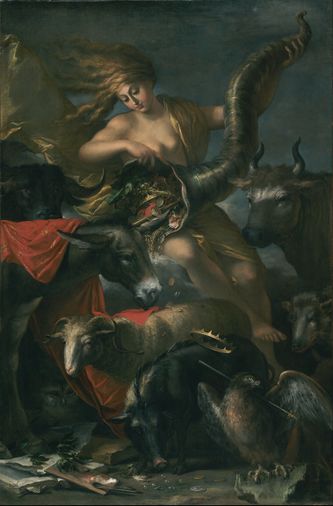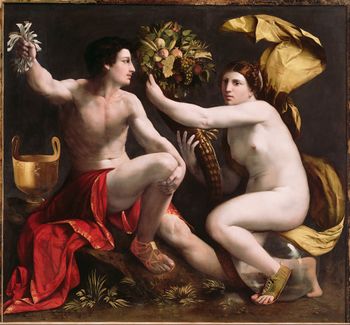أمثولة الثروة
| أمثولة الثروة Allegory of Fortune | |
|---|---|
 | |
| الفنان | سلڤاتور روزا |
| السنة | 1658 |
| النوع | رسم بالزيت على كانڤاس |
| الأبعاد | 200.7 cm × 133 cm (79.0 in × 52 in) |
| الموقع | متحف پول گتي |
أمثولة الثروة Allegory of Fortune، أحياناً تُسمى لا فورتونا La Fortuna، هي رسم زيتي على كانڤاس، رُسِمت حوالي سنة 1658 أو 1659 بريشة رسام الباروك الإيطالي سلڤاتور روزا، وقد أثارت غضباً واسعاً حين عُرِضت لأول مرة على الملأ، وكادت تتسبب في سجن الرسام وتعرضه للحرمان الكنسي. وهي تحمل الحروف الأولى للرسام، بدون تاريخ، ومقاساتها 200.7×133 سم. كان روزا معروفاً بلوحات المناظر الطبيعية، إلا أنه عمل أيضاً في مواضيع الأساطير والسحر والپورتريهات والسخرية.[1] ومنذ 1978 فاللوحة موجودة في متحف پول گتي في ماليبو، كاليفورنيا.
. . . . . . . . . . . . . . . . . . . . . . . . . . . . . . . . . . . . . . . . . . . . . . . . . . . . . . . . . . . . . . . . . . . . . . . . . . . . . . . . . . . . . . . . . . . . . . . . . . . . . . . . . . . . . . . . . . . . . . . . . . . . . . . . . . . . . . . . . . . . . . . . . . . . . . . . . . . . . . . . . . . . . . . .
الخلفية
اللوحة رُسِمت في نفس الوقت الذي كتب فيه روزا بابيلونيا Babilonia، الإدانة الساخرة للبلاط الپاپوي.[2][أ] According to art critic Brian Sewell, the target of the satirical painting could not be misinterpreted.[2] Rosa's friends warned him after viewing it privately,[4] that the painting should not be displayed openly as it was a satirical attack on Pope Alexander VII's patronage.[5] In 1659 the painting was exhibited at the Pantheon, Rome, which almost resulted in Rosa being jailed and excommunicated. Only the intervention of the pope's brother, Don Marco Chigi, saved him from this humiliation.[4]
Eventually Rosa was convinced of the need to offer an explanation of the picture; this he did under the rubric of Manifesto and, according to art writer James Elmes, "proved that his hogs were not churchmen, his mules pretending pedants, his asses Roman nobles, and his birds and beasts of prey, the reigning despots of Italy."[6]
An earlier painting of Fortune was undertaken by Rosa during the 1640s.[7]
الوصف
The overall dimensions of the undated oil on canvas are 200.7 by 133 centimetres (79.0 in × 52.4 in) wide;[8] the initials "SR" inscribed on the book at the lower left represent the signature of the artist.[9] The painting, sometimes referred to as La Fortuna,[10] depicts Fortuna, the goddess of fortune and personification of luck, pouring her gifts on an array of undeserving animals. Traditionally Fortuna has her eyes covered and the vessel containing her favours, the horn of plenty or Cornucopia, is shown in an upright position; Rosa has reversed this tradition in his rendition and portrays Fortuna completely acquainted with where and on whom she is bestowing her gifts from the upended cornucopia.[8]
Gemstones, coronets, a sceptre, gold coins, pearls, roses, together with grapes, cereal, and berries flow from the cornucopia onto the animals below.[11] In turn the animals are stamping on the symbols of education, the arts, and knowledge. The donkey, the symbol of the pope, wearing a cardinal's red and gold coat as a drapery, is suppressing and casting a shadow on an owl, used here as the symbol for wisdom. The painting is expressing the artist's feelings of bitterness about the fact he lost the papal patronage, and thus Rosa included personal references: a rose signifies Rosa's name; a palette is placed on the book, and the book carries his initials. A pig stepping on a rose also symbolizes the same thing.[8]
المعارض والمصدر

بعد عرضها في 1659، اللوحة اقتناها كارلو دى روسي، وبوفاته حوالي 1683 انتقلت ملكيتها إلى أنطونيو ڤالوري.[9]
It moved from Italy to England after Vallori sold it to Henry Scudamore, 3rd Duke of Beaufort in 1727[7] for six hundred scudi.[12] The duke was completing a Grand Tour and purchased two Rosa paintings, the other one entitled, Nursing of Jupiter.[13] Passed down by inheritance, the Fortune painting remained in the possession of the various Dukes of Beaufort until sold by the tenth duke in 1957, when it was purchased by the Marlborough Gallery. It was acquired by J. Paul Getty from the gallery in 1971.[9] Until it passed to the Getty Museum in 1978 it was only exhibited three times: from 21 May 1827 at the Bristol Institution; at the British Institution in 1859; and as part of the J. Paul Getty Collection exhibition in the summer of 1972 at the معهد منياپوليس للفنون. In the twenty-first century it has been displayed as part of the Bandits, Wilderness and Magic exhibition firstly at Dulwich Picture Gallery in London during 2010 and at the Kimbell Art Museum in Texas from the end of December 2010 to March 2011.[9]
الهامش
ملاحظات
هامش
- ^
"Rosa Art Competition", Dulwich Gallery, archived from the original on 19 February 2015, retrieved 19 February 2015
{{cite web}}: Unknown parameter|deadurl=ignored (|url-status=suggested) (help) - ^ أ ب Sewell, Brian (16 September 2010), "Exhibition of the week", The Evening Standard, https://www.questia.com/read/1G1-237234412
- ^ Fredericksen1991, p. 543
- ^ أ ب Fredericksen (1980), p. 18
- ^
Langdon, Helen, "Rosa, Salvator", Grove Art Online, Oxford University Press, retrieved 19 February 2015
{{cite web}}: Unknown parameter|subscription=ignored (|url-access=suggested) (help) - ^ Elmes (1825), p. 92
- ^ أ ب Roworth (1975), p. 663
- ^ أ ب ت
"Allegory of Fortune, Salvator Rosa (Italian, 1615 – 1673)", Google Art Project, archived from the original on 19 February 2015, retrieved 19 February 2015
{{cite web}}: Unknown parameter|deadurl=ignored (|url-status=suggested) (help) - ^ أ ب ت ث
"Allegory of Fortune (Getty Museum)", The J. Paul Getty in Los Angeles, archived from the original on 19 February 2015, retrieved 19 February 2015
{{cite web}}: Unknown parameter|deadurl=ignored (|url-status=suggested) (help) - ^ Viers (2008), p. 86
- ^ Roworth (1975), p. 664
- ^ Morgan (1824), p. 16
- ^ Nicolson (1957), p. 416
ببليوگرافيا
- Elmes, James (1825), The Arts and Artists: Or Anecdotes & Relics, of the Schools of Painting, Sculpture & Architecture, J. Knight & H. Lacey, https://books.google.com/books?id=q8xAAAAAYAAJ&pg=PA91
- Fredericksen, Burton B. (1980), Masterpieces of Painting in the J. Paul Getty Museum: First Edition, Getty Publications, ISBN 978-0-89236-022-2, https://books.google.com/books?id=1NdTAgAAQBAJ&pg=PT44
- Fredericksen, Burton B. (1991), "A Pair of Pendant Pictures by Claude Lorrain and Salvator Rosa from the Chigi Collection", The Burlington Magazine 133 (1061)
- Morgan, Lady Sydney (1824), The Life and Times of Salvator Rosa, H. Colburn, https://books.google.com/books?id=OPoDAAAAYAAJ&pg=GBS.PA16
- Nicolson, Benedict (1957), "Two Salvator Rosas from Badminton", The Burlington Magazine 99 (657)
- Roworth, Wendy (1975), "Salvator Rosa's Lost Painting of 'Fortuna'", The Burlington Magazine 117 (871)
- Viers, Carole Anne (2008), The OULIPO and Art as Retrieval, ProQuest, ISBN 978-0-549-72075-1, https://books.google.com/books?id=wCtrjZpbdVcC&pg=PA86